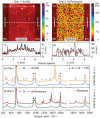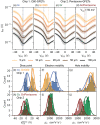The Effect of C60 and Pentacene Adsorbates on the Electrical Properties of CVD Graphene on SiO2
- PMID: 36986028
- PMCID: PMC10052095
- DOI: 10.3390/nano13061134
The Effect of C60 and Pentacene Adsorbates on the Electrical Properties of CVD Graphene on SiO2
Abstract
Graphene is an excellent 2D material for vertical organic transistors electrodes due to its weak electrostatic screening and field-tunable work function, in addition to its high conductivity, flexibility and optical transparency. Nevertheless, the interaction between graphene and other carbon-based materials, including small organic molecules, can affect the graphene electrical properties and therefore, the device performances. This work investigates the effects of thermally evaporated C60 (n-type) and Pentacene (p-type) thin films on the in-plane charge transport properties of large area CVD graphene under vacuum. This study was performed on a population of 300 graphene field effect transistors. The output characteristic of the transistors revealed that a C60 thin film adsorbate increased the graphene hole density by (1.65 ± 0.36) × 1012 cm-2, whereas a Pentacene thin film increased the graphene electron density by (0.55 ± 0.54) × 1012 cm-2. Hence, C60 induced a graphene Fermi energy downshift of about 100 meV, while Pentacene induced a Fermi energy upshift of about 120 meV. In both cases, the increase in charge carriers was accompanied by a reduced charge mobility, which resulted in a larger graphene sheet resistance of about 3 kΩ at the Dirac point. Interestingly, the contact resistance, which varied in the range 200 Ω-1 kΩ, was not significantly affected by the deposition of the organic molecules.
Keywords: C60; Pentacene; field effect; graphene; heterostructures; hybrid; organic; semiconductor; transistor; van der Waals.
Conflict of interest statement
The authors declare no conflict of interest.
Figures




References
-
- Garg R., Elmas S., Nann T., Andersson M.R. Deposition Methods of Graphene as Electrode Material for Organic Solar Cells. Adv. Energy Mater. 2017;7:1601393. doi: 10.1002/aenm.201601393. - DOI
-
- Adetayo A.E., Ahmed T.N., Zakhidov A., Beall G.W. Improvements of Organic Light-Emitting Diodes Using Graphene as an Emerging and Efficient Transparent Conducting Electrode Material. Adv. Opt. Mater. 2021;9:2002102. doi: 10.1002/adom.202002102. - DOI
-
- Liu L., Liu Y., Duan X. Graphene-Based Vertical Thin Film Transistors. Sci. China Inf. Sci. 2020;63:201401. doi: 10.1007/s11432-020-2806-8. - DOI
Grants and funding
LinkOut - more resources
Full Text Sources

